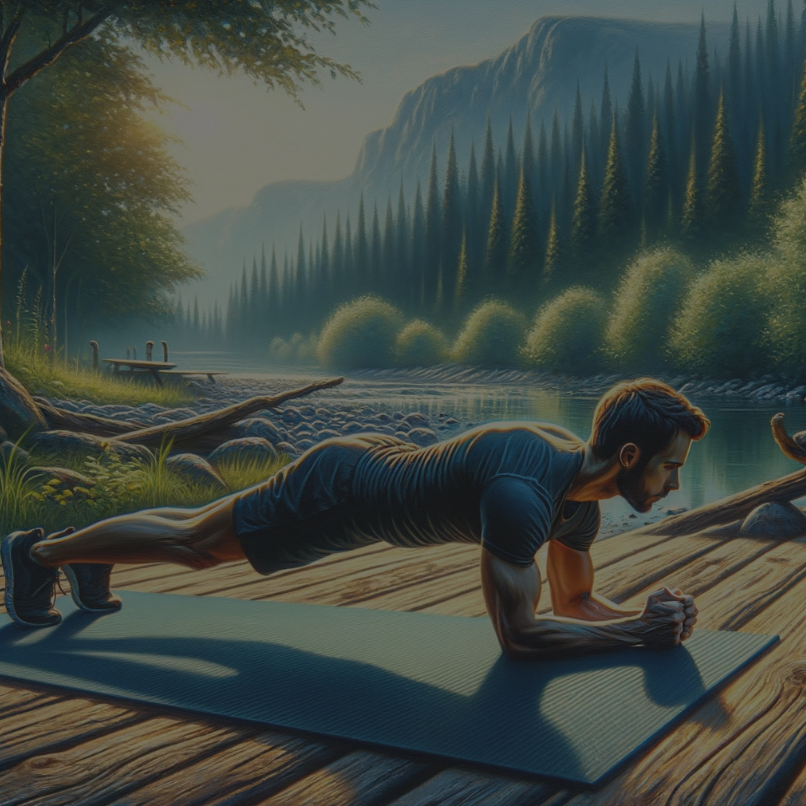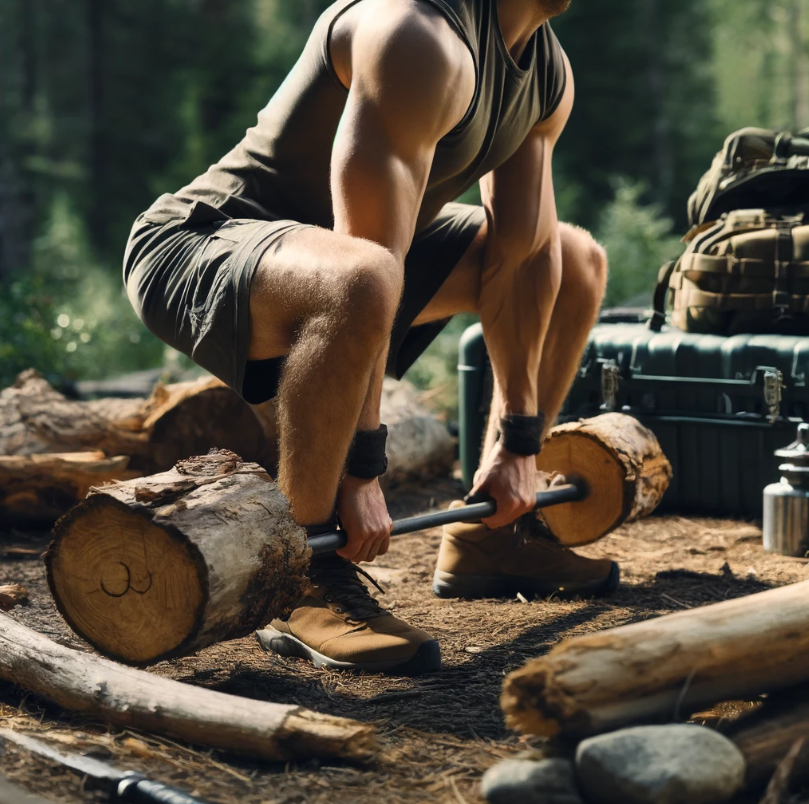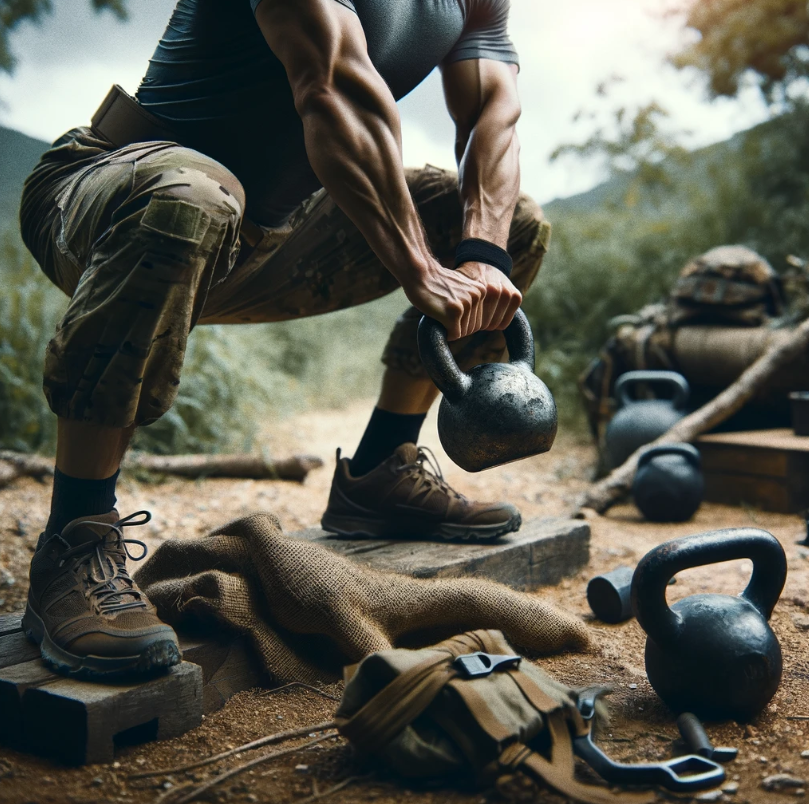Table of Contents
- 1 Key Takeaways
- 2 Use Functional Training To Mimic Real Emergencies
- 3 Bodyweight Survival Exercises You Can Do Anywhere
- 4 Bulgarian Split Squat
- 5 Planks and Prone Back Extensions
- 6 Pushups
- 7 Burpees
- 8 Deadlift
- 9 Kettlebell Squats / Swings
- 10 Farmer Carry
- 11 Stretches and Agility
- 12 Final Remarks on Survival Workout Routines
- 13 Frequently Asked Questions
- 13.1 What is the importance of using functional training in survival workout routines?
- 13.2 How can bodyweight survival exercises benefit my fitness routine?
- 13.3 Why are burpees considered an effective part of survival workout routines?
- 13.4 What are the benefits of incorporating deadlifts into survival workout routines?
- 13.5 How do kettlebell squats/swings contribute to enhancing survival workout routines and fitness levels?
Views: 20
Discover the ultimate collection of survival workout routines designed to challenge and transform your body. Whether you’re a beginner or a seasoned fitness enthusiast, these routines will help you stay strong, agile, and ready for anything life throws your way. Scroll down for reviews of our top picks and start your fitness adventure now.
Key Takeaways
- Incorporate functional training into your survival workout routines to simulate real-life emergency preparedness in crisis situations effectively.
- Utilize bodyweight exercises like Bulgarian split squats, planks, pushups, burpees, and farmer carries for comprehensive survival workout routines.
- Focus on compound movements such as deadlifts and kettlebell squats/swings to build strength and endurance essential for survival scenarios.
- Prioritize exercises that enhance agility and flexibility through stretches and agility drills to improve overall physical preparedness.
- Perform these exercises consistently to improve your physical fitness levels and be better equipped to handle unexpected challenges.
- Remember, the key to survival is not just physical strength but also mental resilience and preparedness. Stay committed to your workout routine for long-term benefits.
Use Functional Training To Mimic Real Emergencies

Functional training in survival workout routines involves exercises that replicate real-life emergency scenarios, preparing individuals for unforeseen situations. By prioritizing functional movements, these programs aim to enhance survival skills through physical conditioning and mental preparedness.
Key Features:
- Realistic Simulations: Exercises are designed to mimic emergencies like climbing obstacles, carrying heavy loads, or crawling through confined spaces.
- Adaptive Response: Participants learn to adapt quickly to changing environments and stressors, building resilience and critical thinking abilities.
- Practical Application: Skills acquired in these routines can be directly applied in emergency situations, increasing the chances of survival.
Insights:
- According to research, functional training not only improves physical strength but also enhances cognitive functions and decision-making under pressure.
- A study showed that individuals who trained with functional movements displayed a higher level of situational awareness and problem-solving skills during simulated emergencies.
Incorporating such programs into your fitness routine can significantly boost your overall preparedness for unexpected events. By focusing on practical movements that mirror real-life challenges, you can better equip yourself to handle emergencies effectively. Remember, being physically fit is not just about looking good; it’s about being ready for whatever life throws your way.
Bodyweight Survival Exercises You Can Do Anywhere
Engage in bodyweight exercises for convenience and adaptability to various environments. These workouts require no equipment, making them ideal for survival situations where resources are limited. Incorporating a range of bodyweight exercises into your routine ensures a comprehensive workout targeting different muscle groups.

- Push-ups: Targeting the chest, shoulders, and triceps, push-ups are versatile and effective.
- Squats: Ideal for working the lower body muscles including quads, hamstrings, and glutes.
- Planks: Strengthen your core muscles by holding a plank position for extended periods.
- Lunges: Work on leg muscles while improving balance and stability.
Performing these exercises regularly can enhance your physical strength and endurance, crucial for surviving challenging situations. The simplicity of bodyweight exercises allows you to maintain your fitness regimen even when resources are scarce.
Survival activities often require individuals to be physically fit and ready for unexpected challenges. By incorporating bodyweight exercises into your workout plan, you prepare yourself to stay active and agile in any circumstance. Water scarcity or lack of gym equipment should not hinder your fitness goals when you can rely on bodyweight exercises to keep you in shape.
Bulgarian Split Squat

Bulgarian split squats are a powerful addition to workout routines for those aiming to boost lower body strength. This exercise stands out for its ability to target multiple muscle groups at once, including the quads, hamstrings, and glutes. By incorporating Bulgarian split squats into your routine, you can effectively engage these key muscles, promoting overall lower body strength and endurance.
One of the standout features of Bulgarian split squats is their capacity to enhance balance and stability. Unlike traditional squats, this exercise requires unilateral leg movement, challenging your core and stabilizing muscles to work harder to maintain proper form. This not only helps in improving balance but also contributes to functional fitness by mimicking real-life movements that require stability and coordination.
Moreover, the Bulgarian split squat is a versatile exercise that can be modified based on fitness levels. Whether you’re a beginner or an advanced fitness enthusiast, you can adjust factors like depth of the lunge and added weights to tailor the intensity of the workout to suit your needs. This adaptability makes it an excellent choice for individuals looking to progress in their fitness journey while continually challenging themselves.
Incorporating Bulgarian split squats into your workout routine can lead to significant improvements in lower body strength, balance, and stability. Consider adding this dynamic exercise to your regimen for a well-rounded approach to achieving your fitness goals.
Planks and Prone Back Extensions
Planks and prone back extensions are core-strengthening exercises that offer a range of benefits beyond just sculpting your abs. By incorporating these exercises into your routine, you can improve posture and reduce the risk of back pain significantly.

- Core Stability: Planks work on the entire core, including the transverse abdominis, rectus abdominis, obliques, and lower back muscles.
- Back Strength: Prone back extensions target the erector spinae muscles along your spine, promoting better posture and reducing the likelihood of back injuries.
Engaging in isometric exercises like planks not only strengthens your core but also enhances overall stability by requiring you to hold a position for an extended period. This static contraction helps build endurance and resilience in your core muscles.
By consistently integrating planks and prone back extensions into your workout regimen, you can experience improved functional strength for daily activities. These exercises are versatile and can be modified to suit different fitness levels, making them suitable for beginners to advanced individuals looking to enhance their core strength and stability.
If you’re aiming to fortify your core, improve posture, and prevent back pain effectively, consider adding planks and prone back extensions to your survival workout routines.
Pushups

Pushups are versatile exercises that can significantly improve upper body strength. They target key muscle groups such as the chest, shoulders, and triceps effectively. By incorporating pushups into your workout, you can enhance muscle tone and endurance in these areas.
Pushup variations offer a range of intensity levels to suit different fitness levels. Beginners can start with knee pushups or wall pushups to build strength gradually. As you progress, standard pushups on the toes provide a more challenging workout. For advanced exercisers, plyometric pushups or one-arm pushups can take your routine to the next level.
Consistency is key when it comes to seeing improvements in strength and muscle definition through pushups. Aim for a specific number of reps per set and gradually increase this number as you get stronger. Tracking your progress can be a great source of motivation, showing how far you’ve come since starting your pushup routine.
Incorporating pushups into your regular exercise regimen not only helps in building upper body strength but also contributes to overall functional fitness. Whether you’re looking to tone your muscles, improve posture, or increase upper body endurance, pushups are an excellent addition to any workout routine.
Burpees
Burpees are an excellent addition to survival workout routines, offering a comprehensive full-body conditioning workout that combines both strength and cardio elements. By incorporating burpees into your routine, you can efficiently work multiple muscle groups simultaneously, making it a time-efficient exercise choice.

Engaging in burpees regularly can significantly improve your cardiovascular endurance. This exercise involves rapid movements that elevate your heart rate, helping to enhance your overall cardiovascular health and stamina over time. It is a high-intensity exercise that can effectively burn calories and boost metabolism, aiding in weight management and fat loss goals.
One of the key benefits of burpees is their ability to provide a challenging workout that targets various muscle groups, including the arms, chest, core, glutes, and legs. This full-body engagement makes burpees a versatile exercise suitable for individuals looking to improve their overall fitness levels.
Integrating burpees into your routine allows you to efficiently break a sweat while reaping the benefits of both strength training and cardiovascular exercise. This dynamic movement not only helps in building strength but also contributes to enhancing agility and coordination.
Deadlift

Deadlifts, a fundamental exercise in any workout routine, are exceptional for strengthening the posterior chain. By incorporating deadlifts into your workout regimen, you can significantly enhance your overall strength and fitness levels. You can use things from your environment if you don’t have the actual weights available.
- Focus on proper form: When performing deadlifts, it is crucial to pay close attention to your form and technique. This ensures that you target the intended muscle groups effectively and reduce the risk of injury.
- Functional strength: Deadlifts not only help build raw strength but also improve functional strength. This means that the strength gained from deadlifting translates well into real-life movements and activities.
- Posterior chain: The primary muscles worked during deadlifts include the hamstrings, glutes, lower back, and traps. Strengthening these muscles is essential for maintaining good posture, preventing injuries, and enhancing athletic performance.
Incorporating deadlifts into your workout routine can have a profound impact on your overall fitness level. With a focus on proper form and technique, you can maximize the benefits of this compound exercise and see significant improvements in your strength and muscle development.
Kettlebell Squats / Swings
Kettlebell squats and swings are dynamic exercises that focus on enhancing lower body power. These movements not only target specific muscle groups but also contribute to overall fitness levels. By incorporating kettlebell exercises into your routine, you can build functional strength that translates into real-world activities.

- Lower Body Power: Kettlebell squats and swings specifically target the muscles in your legs, hips, and glutes, helping to improve strength and power in these areas.
- Cardiovascular Endurance: The fast-paced nature of kettlebell swings elevates your heart rate, providing a cardiovascular workout alongside strength training.
- Core Stability: Both squats and swings engage your core muscles to stabilize your body during the movements, leading to improved core strength over time.
Incorporating kettlebell squats and swings into your workout routine can offer a well-rounded approach to fitness. These exercises not only help in building muscle but also contribute to improving endurance, flexibility, and balance.
Farmer Carry

Farmer carry is a versatile workout that can significantly benefit your grip strength and endurance. By incorporating this exercise into your routine, you simulate the action of carrying heavy objects, which can be crucial in emergency situations. This workout not only targets specific muscle groups but also enhances overall strength and stability.
- Grip Strength: Farmer carries are known to be highly effective in improving grip strength, which is essential for various daily tasks and activities.
- Endurance Boost: Engaging in farmer carries regularly can help increase your endurance levels, allowing you to sustain physical exertion for longer periods.
- Functional Strength: This exercise mimics real-life scenarios where you may need to transport heavy items over distances, making it a practical addition to all survival workout routines.
Incorporating farmer carries into your fitness regimen can prepare you for unforeseen circumstances where physical strength and endurance are paramount. Whether it’s carrying supplies, navigating rough terrain, or evading predators, this exercise equips you with the necessary skills to handle challenging situations effectively.
Stretches and Agility
Incorporating dynamic stretches in your workout routine can significantly enhance your flexibility and mobility. These stretches involve continuous movement, activating muscles and increasing blood flow, which is crucial for preparing your body for exercise.

Improving agility is key to boosting coordination and quickness. By including activities that focus on quick directional changes and coordination, you can enhance your overall agility levels, benefiting various aspects of fitness and daily movements.
Prioritizing stretching not only helps in preventing injuries but also plays a vital role in enhancing athletic performance. By incorporating static stretches after workouts, you can improve muscle recovery, reduce muscle soreness, and increase overall flexibility.
By dedicating time to these stretches and agility exercises, you are not only investing in your physical well-being but also ensuring that your body is adequately prepared for any physical activity or sport. Consistency in these exercises can lead to long-term benefits such as improved posture, reduced risk of injury, and enhanced overall performance in various physical activities.
Make it a habit to include dynamic stretches and agility exercises in your workout routine to reap the numerous benefits they offer. Your body will thank you for the care and attention you provide through these essential components of a well-rounded fitness regimen.
Final Remarks on Survival Workout Routines

Incorporating survival workout routines into your fitness regimen equips you with the physical strength and mental resilience needed to tackle unexpected challenges. By engaging in functional training exercises that simulate real-life emergencies, you are preparing yourself for any situation that may come your way. From bodyweight exercises like pushups and burpees to weighted movements such as deadlifts and kettlebell squats, each routine enhances your overall preparedness and agility.
Take the first step today by integrating these survival workout routines into your daily exercise regimen. Strengthen your body, sharpen your mind, and boost your confidence knowing that you are ready to face whatever obstacles life throws at you. Your commitment to this training will not only improve your physical fitness but also instill a sense of empowerment and readiness for any unforeseen circumstances.
Frequently Asked Questions
What is the importance of using functional training in survival workout routines?
Functional training helps simulate real-life emergencies, improving your body’s ability to respond effectively in crisis situations. By mimicking practical movements, it enhances strength, agility, and coordination crucial for survival scenarios. This can help you be ready in times of natural disaster or other crisis!
How can bodyweight survival exercises benefit my fitness routine?
Bodyweight exercises offer versatility and convenience, allowing you to train anywhere without equipment. They improve muscle endurance, flexibility, and overall strength, essential for surviving challenging situations with limited resources.
Why are burpees considered an effective part of survival workout routines?
Burpees are a full-body exercise that combines strength training and cardiovascular conditioning. They enhance stamina, muscle power, and agility – key components for surviving emergencies requiring quick bursts of energy and physical exertion.
What are the benefits of incorporating deadlifts into survival workout routines?
Deadlifts strengthen multiple muscle groups simultaneously, promoting overall body strength and resilience. This exercise improves posture, grip strength, and lower back stability – essential for lifting heavy objects or navigating challenging terrains during emergencies.
How do kettlebell squats/swings contribute to enhancing survival workout routines and fitness levels?
Kettlebell squats/swings improve functional strength, explosive power, and cardiovascular endurance – vital aspects for survival preparedness. These dynamic exercises target various muscle groups efficiently while building resilience against physical demands in emergency situations.




Pingback: SHTF Fitness: Physical Preparedness for Survival
Pingback: Disaster Planning Made Easy: Effective Training & Drills For Peace Of Mind
Pingback: Sharpen Your Response: Emergency Preparedness Training Drills
Pingback: Sharpen Your Response: Emergency Preparedness Training Drills - Learn&Lock
Pingback: Organize Training Exercises